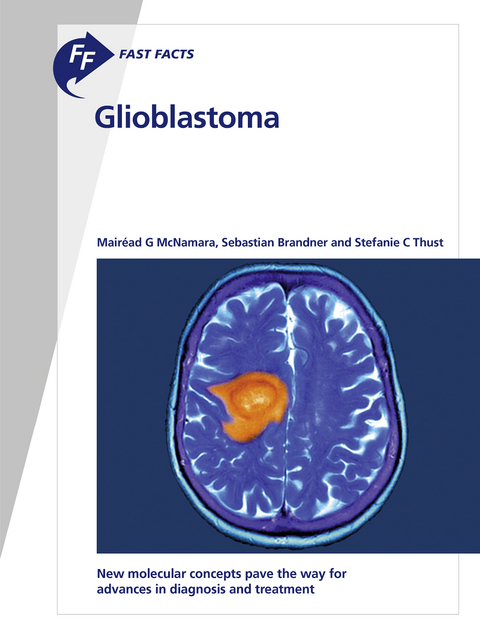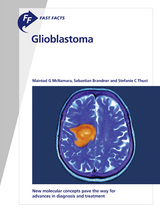Fast Facts: Glioblastoma
New Molecular Concepts Pave the Way for Advances in Diagnosis and Treatment
Seiten
2020
S. Karger Publishers Ltd (Verlag)
978-1-912776-70-2 (ISBN)
S. Karger Publishers Ltd (Verlag)
978-1-912776-70-2 (ISBN)
Glioblastoma (also known as glioblastoma multiforme) is a malignant intrinsic tumor thought to arise from populations of stem/progenitor cells in the brain. Contents: * Epidemiology, pathophysiology and classification * Clinical presentation * Diagnosis * Management * Treatment of associated conditions * Emerging research and treatment
Glioblastoma (also known as glioblastoma multiforme) is a malignant intrinsic tumor thought to arise from populations of stem/progenitor cells in the brain. It is the most common aggressive intrinsic brain tumor in adults, with the potential to spread rapidly within the brain. Patients with glioblastoma face a poor prognosis, with median overall survival of approximately 15 months. However, our growing understanding of the molecular biology of gliomas means that this outlook may be improving. The identification of clinically relevant subgroups defined by specific genetic mutations is challenging the traditional delineation between low- and high-grade gliomas that has been based on histological appearance and imaging. Indeed, it is becoming clear that, as a molecular entity, a glioblastoma, which by traditional classification is a grade IV glioma, may present with a lower grade initially and then become more aggressive - an important addition to the established concept. The care of a patient with a glioblastoma requires a coordinated approach delivered by a multidisciplinary team, with the aim of maintaining quality of life for as long as possible. Here, we provide a concise overview of the diagnosis and management of glioblastoma, as well as discussion of our emerging understanding of the molecular drivers that are helping us to delineate different patient subgroups. These subgroups will, hopefully, allow more targeted treatments in the future. This resource will be of interest to all those involved in caring for patients with this aggressive brain tumor, including neurologists, neurosurgeons, neuro-oncologists, radiation oncologists, palliative care specialists, specialist nurses and medical students. Contents: * Epidemiology, pathophysiology and classification * Clinical presentation * Diagnosis * Management * Treatment of associated conditions * Emerging research and treatment
Glioblastoma (also known as glioblastoma multiforme) is a malignant intrinsic tumor thought to arise from populations of stem/progenitor cells in the brain. It is the most common aggressive intrinsic brain tumor in adults, with the potential to spread rapidly within the brain. Patients with glioblastoma face a poor prognosis, with median overall survival of approximately 15 months. However, our growing understanding of the molecular biology of gliomas means that this outlook may be improving. The identification of clinically relevant subgroups defined by specific genetic mutations is challenging the traditional delineation between low- and high-grade gliomas that has been based on histological appearance and imaging. Indeed, it is becoming clear that, as a molecular entity, a glioblastoma, which by traditional classification is a grade IV glioma, may present with a lower grade initially and then become more aggressive - an important addition to the established concept. The care of a patient with a glioblastoma requires a coordinated approach delivered by a multidisciplinary team, with the aim of maintaining quality of life for as long as possible. Here, we provide a concise overview of the diagnosis and management of glioblastoma, as well as discussion of our emerging understanding of the molecular drivers that are helping us to delineate different patient subgroups. These subgroups will, hopefully, allow more targeted treatments in the future. This resource will be of interest to all those involved in caring for patients with this aggressive brain tumor, including neurologists, neurosurgeons, neuro-oncologists, radiation oncologists, palliative care specialists, specialist nurses and medical students. Contents: * Epidemiology, pathophysiology and classification * Clinical presentation * Diagnosis * Management * Treatment of associated conditions * Emerging research and treatment
| Erscheinungsdatum | 06.03.2020 |
|---|---|
| Zusatzinfo | 17 fig., 12 in color, 3 tab. |
| Verlagsort | Basel |
| Sprache | englisch |
| Maße | 148 x 210 mm |
| Gewicht | 150 g |
| Themenwelt | Medizinische Fachgebiete ► Innere Medizin ► Hämatologie |
| Medizin / Pharmazie ► Medizinische Fachgebiete ► Onkologie | |
| Schlagworte | Hematology |
| ISBN-10 | 1-912776-70-7 / 1912776707 |
| ISBN-13 | 978-1-912776-70-2 / 9781912776702 |
| Zustand | Neuware |
| Haben Sie eine Frage zum Produkt? |
Mehr entdecken
aus dem Bereich
aus dem Bereich
Hämatologie und Internistische Onkologie
Buch | Softcover (2023)
ecomed-Storck GmbH (Verlag)
129,99 €
Buch | Softcover (2024)
Urban & Fischer in Elsevier (Verlag)
54,00 €




